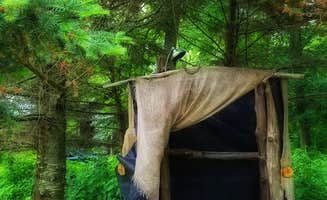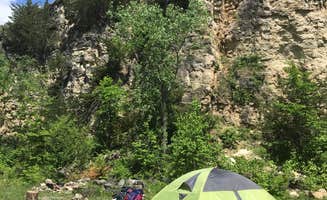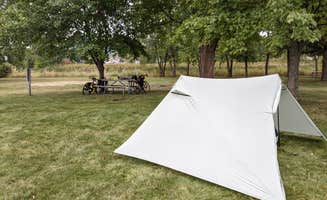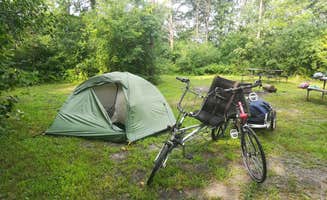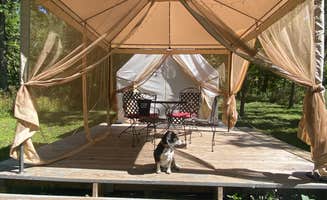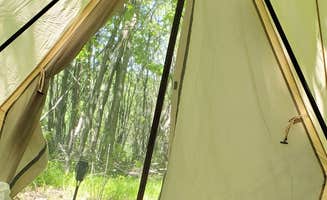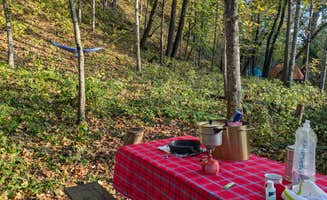Tent camping near Onalaska, Wisconsin offers access to the Driftless Region's unique geography, characterized by steep ridges, deep valleys and limestone bluffs untouched by glacial activity. The area sits at elevations ranging from 640-1,300 feet, with summer temperatures averaging 70-85°F during peak camping months. Most campgrounds maintain seasonal operations from April through October, with limited winter availability.
What to do
Biking trails access: The Houston Nature Center serves as a trailhead for the Root River State Bike Trail, offering walk-in tent sites with basic amenities. "The Nature Center has clean bathrooms and free showers. They recommend donations for the use of the showers," notes one visitor. Another camper adds that "the Nature Center also has a bike servicing station, showers, and bathrooms."
Animal interactions: At Shady Rest Acres, campers can enjoy a unique farm experience alongside traditional tent camping. "They have donkeys, Scottish Highland cows (a family of them), sheep, goats, chickens... bees, horses, ducks, cats and dogs," explains one reviewer. The owners "are happy to let you meet them with their presence."
Water activities: Wazee Lake Recreation Area provides tent campers with access to Wisconsin's deepest and clearest inland lake. "The water is so clear, the trout fishing is great and so is the beach!" reports a visitor. The lake is non-motorized to maintain quiet conditions, making it ideal for swimming, fishing, and scuba diving during warmer months.
What campers like
Privacy between sites: The Sparta Campground along the Elroy-Sparta State Bike Trail offers well-spaced tent sites. "The sites are simple, well separated with a very short walk, easy to take multiple trips," notes a recent visitor. The campground provides basic amenities with "water, pit toilets, tables and fire rings."
Natural features: RJD Memorial Hardwood State Forest offers dispersed tent camping opportunities with scenic backdrops. "We backpacked to the quarry and found a large open area, perfect for multiple tents. The sandstone bluffs were in the background," shares one camper. The forest includes "hiking trails, including a trail that goes on top of the bluff with views of the forest and of Wisconsin and the Mississippi River."
Low traffic sites: Northend Campground provides tent sites along Rush Creek with easy access to town amenities. "Small lil park that they allow people to camp in... Nice sand bottom creek to swim in right behind campground, pool is a few blocks away," describes a visitor. The location allows tent campers to enjoy both natural settings and nearby conveniences.
What you should know
Walk-in requirements: Many tent sites near Onalaska require varying amounts of walking from parking areas. At Justin Trails Resort, tent camping areas require a short walk from the main facilities. The resort offers additional amenities like breakfast options and a small store that "sells wine and food."
Seasonal variations: Most tent campgrounds in the area operate primarily from May through October, with limited off-season availability. Some forest camping areas become hunting grounds during fall seasons. Weather variations can affect site conditions, especially during spring when trails may be muddy.
Noise considerations: Highway proximity affects some campgrounds. At Sparta Campground, one camper noted "it's very near the interstate so not the quietest of places," while another mentioned needing "noise-cancelling headphones to drown out the noise in order to sleep." Weekday traffic tends to be louder than weekend traffic at sites near major roads.
Tips for camping with families
Natural playgrounds: Several area campgrounds offer child-friendly features beyond standard playground equipment. Houston Nature Center includes "a 1 acre natural playground near the campsite" with "a zip line, tree house, small rock wall, and more." Most tent sites are within walking distance of these play areas.
Educational opportunities: Tent campers with children can supplement outdoor activities with learning experiences at Wazee Lake Rec Area. The lake's clear waters make it "a popular scuba diving, swimming, and fishing spot," offering chances to observe underwater environments. Nearby nature centers frequently host programs specifically designed for younger campers.
Accessibility considerations: When camping with children, site distance from parking areas becomes particularly important. Some tent sites require walks of up to 600 yards, which can be challenging with young children and gear. Many parents recommend Northend Campground for its proximity to amenities, noting "the town of Rushford is cute, the creamery has great pizza and good ice cream."
Tips for RVers
Limited RV options: While the Onalaska area primarily caters to tent camping, a few locations accommodate smaller RVs. At Houston Nature Center, tent sites predominate but some RVs can be accommodated. One camper notes it's "great tent only campground with walk-in sites," suggesting RVers should call ahead to confirm space availability.
Hookup considerations: Most camping areas near Onalaska offer minimal hookups for RVs. Water access points are available at certain campgrounds, but electrical hookups are rare. RVers should plan for boondocking conditions at most locations, bringing sufficient water and power resources for their stay.
Access challenges: Many forest roads leading to primitive camping areas have tight turns and limited width. Larger RVs should research road conditions before attempting access. Additionally, most walk-in tent camping areas are completely inaccessible to RVs, requiring separate vehicle parking.


